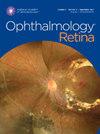Pachyvitelliform Maculopathy
IF 5.7
Q1 OPHTHALMOLOGY
引用次数: 0
Abstract
Purpose
To evaluate the prevalence, clinical features, associated factors, and natural history of pachyvitelliform maculopathy (PVM) within the pachychoroid disease spectrum (PDS).
Design
Retrospective cohort study.
Subjects
Patients affected with PDS were evaluated at a single retina referral center between 2006 and 2024.
Methods
Demographics, medical history, and imaging features were reviewed. Pachyvitelliform maculopathy was diagnosed based on the presence of acquired vitelliform lesions (AVLs), identified as hyperreflective material above the retinal pigment epithelium (RPE) band on spectral-domain OCT and corresponding hyperautofluorescence on fundus autofluorescence imaging. Acquired vitelliform lesions were tracked longitudinally using serial OCT.
Main Outcome Measures
Factors associated with AVL development were assessed using multivariable logistic regression. The hazard of AVL persistence was evaluated with Cox regression. Complication rates were reported as absolute prevalence, and visual acuity (VA) changes were analyzed longitudinally using repeated measures modeling.
Results
Among 986 eyes with PDS, 48 (5%) demonstrated PVM. Key associations included recurrent fluid episodes (odds ratio [OR], 2.87; P = 0.002), thinner outer nuclear layer (OR, 0.89; P = 0.03), and choroidal folds (OR, 3.39; P = 0.002). Subfoveal AVLs were most common, observed in 79% of cases. Acquired vitelliform lesion typically developed at the apex of the subfoveal serous cavity or along its lateral edges, beginning with ellipsoid zone thickening, followed by suspended hyperreflective material settling onto the RPE and forming deposits. These deposits consolidated over time, appearing as “pachydrusen” or resembling the “double-layer sign.” Indocyanine green angiography highlighted localized choroidal vascular hyperpermeability at AVL sites. Subfoveal lesions, a thicker Haller's layer, and increased peripapillary choroidal thickness were associated with reduced AVL resolution (all P < 0.05). Lesion turnover was slow (median 50 months); complications, including neovascularization (6%) and atrophy (4%), were rare, and VA remained stable over 7 years (P = 0.07).
Conclusions
Pachyvitelliform maculopathy represents a distinct phenotype within PDS, characterized by prolonged lesion persistence, recurrent fluid, and a relatively benign visual prognosis. Structural choroidal changes and RPE dysfunction drive lesion formation and progression.
Financial Disclosure(s)
Proprietary or commercial disclosure may be found in the Footnotes and Disclosures at the end of this article.
肿黄斑病变:临床特征、相关因素和自然史。
目的:评价厚脉络膜疾病谱系(PDS)中厚脉络膜样黄斑病变(PVM)的患病率、临床特征、相关因素和自然史。设计:回顾性队列研究。研究对象:2006年至2024年间在单一视网膜转诊中心评估的PDS患者。方法:回顾人口统计学、病史和影像学特征。PVM的诊断是基于获得性卵黄样病变(avl)的存在,在SD-OCT上识别为视网膜色素上皮(RPE)波段以上的高反射物质,在FAF成像上识别为相应的高自身荧光。使用连续oct对AVL进行纵向跟踪。主要结果测量:使用多变量逻辑回归评估与AVL发展相关的因素。采用Cox回归评价AVL持续存在的危险性。并发症发生率报告为绝对患病率,并使用重复测量模型纵向分析视力(VA)变化。结果:986只PDS眼中48只(5%)表现为PVM。主要关联包括反复积液发作(OR: 2.87, p=0.002)、外核层变薄(OR: 0.89, p=0.03)和脉络膜褶皱(OR: 3.39, p=0.002)。中心凹下avl最常见,占79%。AVL通常发生在中央凹下浆液腔的顶端或沿其外侧边缘,开始时椭球区增厚,随后悬浮的高反射物质沉积在RPE上并形成沉积物。这些沉积物随着时间的推移而合并,表现为“厚瘤状”或类似于“双层标志”。ICGA显示AVL部位局部脉络膜血管高通透性。中央凹下病变、更厚的Haller层和乳头周围脉络膜厚度增加与AVL分辨率降低相关(均p < 0.05)。病变更新缓慢(中位50个月);并发症,包括新生血管(6%)和萎缩(4%),是罕见的;VA在7年内保持稳定(p = 0.07)。结论:PVM在PDS中表现出一种独特的表型,其特点是病变持续时间长,反复出现液体,视觉预后相对良好。脉络膜结构改变和RPE功能障碍驱动病变的形成和发展。
本文章由计算机程序翻译,如有差异,请以英文原文为准。
求助全文
约1分钟内获得全文
求助全文

 求助内容:
求助内容: 应助结果提醒方式:
应助结果提醒方式:


